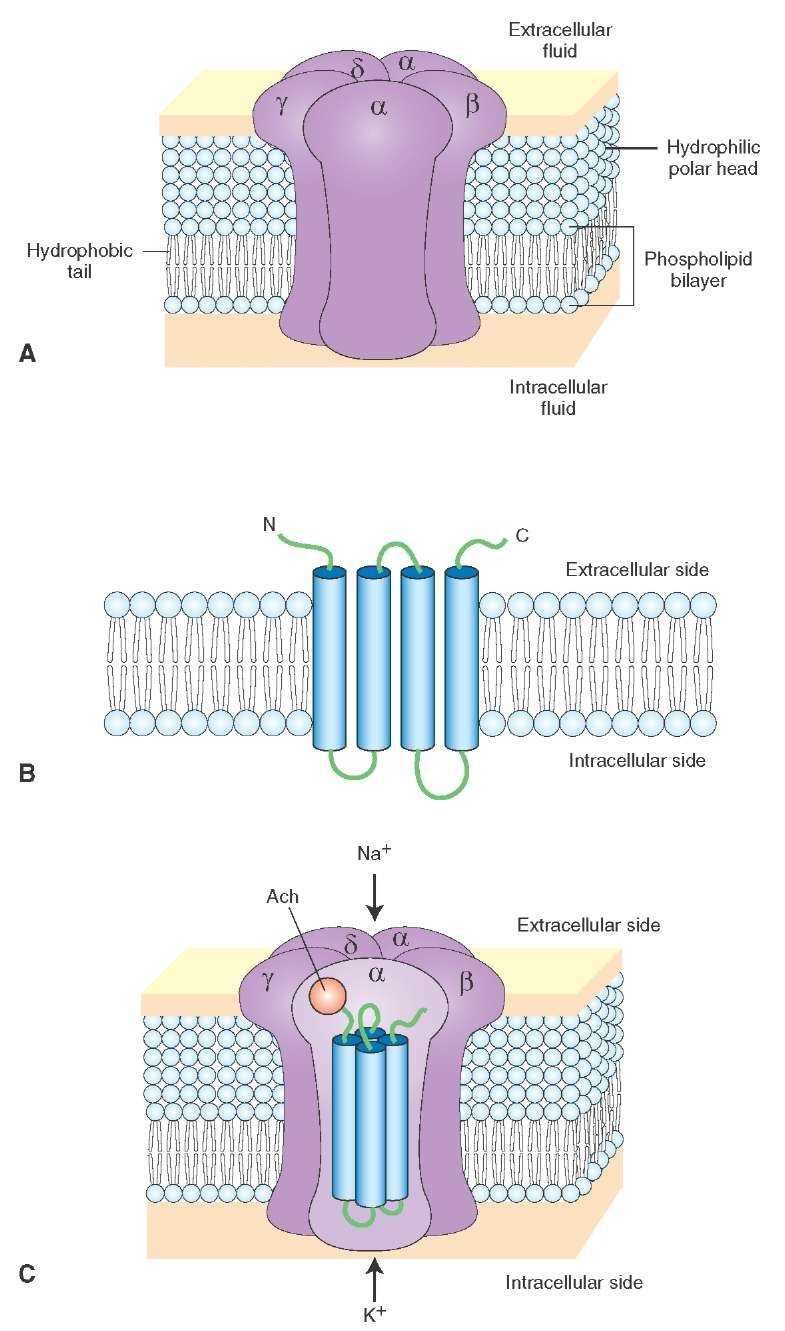Introduction of CHRNA1
The full name of CHRNA1 is acetylcholine receptor subunit alpha. The chemical transmission of electrical signals from the nervous system to skeletal muscle is mediated by the muscle nicotinic acetylcholine receptor (nAChR) at the neuromuscular junction. nAChR consists of five homologous subunits. CHRNA1 is one of the subunits. The gene CHRNA1 encoding the α1 subunit is located on the long arm of chromosome 2, and its encoded product is expressed at neuromuscular junctions. The α subunit displays two adjacent cysteines in the extracellular domain, which are considered to be the major components of the ligand binding site. In addition, it is one of the causative genes of congenital myasthenia gravis syndrome (CMS). CHRNA1 undergoes alternative splicing to generate two splice variants: P3A(-),without exon P3A, and P3A(+), with the exon P3A. Only P3A(−) forms functional nAChR.
| Basic Information of CHRNA1 | |
| Protein Name | Acetylcholine receptor subunit alpha |
| Gene Name | CHRNA1, ACHRA, CHNRA |
| Aliases | / |
| Organism | Homo sapiens (Human) |
| UniProt ID | P02708 |
| Transmembrane Times | 4 |
| Length (aa) | 482 |
| Sequence | MEPWPLLLLFSLCSAGLVLGSEHETRLVAKLFKDYSSVVRPVEDHRQVVEVTVGLQLIQLINVDEVNQIVTTNVRLKQGDMVDLPRPSCVTLGVPLFSHLQNEQWVDYNLKWNPDDYGGVKKIHIPSEKIWRPDLVLYNNADGDFAIVKFTKVLLQYTGHITWTPPAIFKSYCEIIVTHFPFDEQNCSMKLGTWTYDGSVVAINPESDQPDLSNFMESGEWVIKESRGWKHSVTYSCCPDTPYLDITYHFVMQRLPLYFIVNVIIPCLLFSFLTGLVFYLPTDSGEKMTLSISVLLSLTVFLLVIVELIPSTSSAVPLIGKYMLFTMVFVIASIIITVIVINTHHRSPSTHVMPNWVRKVFIDTIPNIMFFSTMKRPSREKQDKKIFTEDIDISDISGKPGPPPMGFHSPLIKHPEVKSAIEGIKYIAETMKSDQESNNAAAEWKYVAMVMDHILLGVFMLVCIIGTLAVFAGRLIELNQQG |
Function of CHRNA1 Membrane Protein
As one of the subunits of the nAChR, CHRNA1 is involved in the regulation of ion channel activity, thereby affecting the contractility of skeletal muscle. The expression levels in the nervous system, brain and placenta are relatively high in healthy human. It has also been found to play a role in diseases such as myasthenia gravis, Alzheimer's disease, cognitive enhancement in schizophrenia, autism spectrum disorders and Down syndrome.
 Fig.1 Nicotinic acetylcholine receptor (nAChR). (A) The nAChR at the neuromuscular junction consists of five protein subunits (α, β, γ, and δ). (B) Each subunit was transmembrane four times. N and C represent the amino (NH2) and carboxyl (COOH) ends, respectively. (C) The transmembrane domain from the five subunits surrounds the central pore of the channel. Acetylcholine (Ach) binds to the a-subunit and opens the channel to allow the influx of Na+ (sodium) and the outflow of K+ (potassium).
Fig.1 Nicotinic acetylcholine receptor (nAChR). (A) The nAChR at the neuromuscular junction consists of five protein subunits (α, β, γ, and δ). (B) Each subunit was transmembrane four times. N and C represent the amino (NH2) and carboxyl (COOH) ends, respectively. (C) The transmembrane domain from the five subunits surrounds the central pore of the channel. Acetylcholine (Ach) binds to the a-subunit and opens the channel to allow the influx of Na+ (sodium) and the outflow of K+ (potassium).
Application of CHRNA1 Membrane Protein in Literature
This genetic analysis showed that very early juvenile-onset myasthenia gravis (JMG) had a more significant genetic susceptibility in the autoantigen gene (CHRNA1).
In this study, 207 patients were recruited for experiments, and it was concluded that the CHRNA1 gene variant did not affect the pharmacodynamics of rocuronium.
This paper found that the extracellular domain of CHRNA1 was an improved protein for antigen-specific myasthenia gravis treatment strategies.
This study found that the expression of CHRNA1 was directly detected from tumors after complete resection. It suggested that in early non-small cell lung cancer (NSCLC), CHRNA1 may be a useful prognostic factor for recurrence and survival.
The study reported that complete or severe dysfunction of AChR in the fetus can lead to lethal multiple pterygium syndrome, while minor changes can lead to fetal hypokinesia with congenital contracture or a myasthenic syndrome later in life.
CHRNA1 Preparation Options
Membrane protein studies have advanced significantly over the past few years. Based on our versatile Magic™ membrane protein production platform, we could offer a series of membrane protein preparation services for worldwide customers in reconstitution forms or membrane protein mutants. Aided by our versatile Magic™ anti-membrane protein antibody discovery platform, we also provide customized anti-CHRNA1 antibody development services.
During the past years, Creative Biolabs has successfully generated many functional membrane proteins for our global customers. We are happy to accelerate the development of our clients’ programs with our one-stop, custom-oriented service. For more detailed information, please feel free to contact us.
All listed services and products are For Research Use Only. Do Not use in any diagnostic or therapeutic applications.